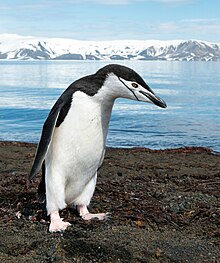
Back Pikkewyn Afrikaans የዋልታ ወፍ Amharic Pinguīn ANG بطريق Arabic بطريق ARZ Spheniscidae AST Ziosk (Spheniscidae) AVK Pinqvinlər Azerbaijani Penguin BAN Pinguin BAR
| Penguins | |
|---|---|

| |
| Chinstrap penguin (Pygoscelis antarctica) | |
| Scientific classification | |
| Domain: | Eukaryota |
| Kingdom: | Animalia |
| Phylum: | Chordata |
| Class: | Aves |
| Clade: | Austrodyptornithes |
| Order: | Sphenisciformes Sharpe, 1891 |
| Family: | Spheniscidae Bonaparte, 1831 |
| Modern genera | |
|
Aptenodytes | |

| |
| Breeding range of penguins, all species (aqua); some species have wider seasonal migration ranges | |
Penguins are a group of aquatic flightless birds from the family Spheniscidae (/sfɪˈnɪsɪdiː, -daɪ/) of the order Sphenisciformes (/sfɪˈnɪsəfɔːrmiːz/).[4] They live almost exclusively in the Southern Hemisphere: only one species, the Galápagos penguin, is found north of the Equator. Highly adapted for life in the ocean water, penguins have countershaded dark and white plumage and flippers for swimming. Most penguins feed on krill, fish, squid and other forms of sea life which they catch with their bills and swallow whole while swimming. A penguin has a spiny tongue and powerful jaws to grip slippery prey.[5]
They spend about half of their lives on land and the other half in the sea. The largest living species is the emperor penguin (Aptenodytes forsteri):[6] on average, adults are about 1.1 m (3 ft 7 in) tall and weigh 35 kg (77 lb). The smallest penguin species is the little blue penguin (Eudyptula minor), also known as the fairy penguin, which stands around 30–33 cm (12–13 in) tall and weighs 1.2–1.3 kg (2.6–2.9 lb).[7] Today, larger penguins generally inhabit colder regions, and smaller penguins inhabit regions with temperate or tropical climates. Some prehistoric penguin species were enormous: as tall or heavy as an adult human. There was a great diversity of species in subantarctic regions, and at least one giant species in a region around 2,000 km south of the equator 35 mya, during the Late Eocene, a climate decidedly warmer than today.[8]
- ^ Tambussi, C.; Hospitaleche, C. A. (2007). "Antarctic birds (Neornithes) during the Cretaceous–Eocene time" (PDF). Revista de la Asociación Geológica. 62 (4): 604–617. Archived (PDF) from the original on April 2, 2021. Retrieved March 21, 2021.
- ^ Hackett, S. J.; Kimball, R. T.; Reddy, S.; Bowie, R. C. K.; Braun, E. L.; Braun, M. J. (2008). "A Phylogenomic Study of Birds Reveals Their Evolutionary History". Science. 320 (5884): 1763–1768. Bibcode:2008Sci...320.1763H. doi:10.1126/science.1157704. PMID 18583609. S2CID 6472805.
- ^ Cite error: The named reference
Ksepkawas invoked but never defined (see the help page). - ^ Gill, Frank; Donsker, David; Rasmussen, Pamela, eds. (2023). "Kagu, Sunbittern, tropicbirds, loons, penguins". World Bird List Version 13.1. International Ornithologists' Union. Retrieved April 16, 2023.
- ^ "Diet and Eating Habits". Sea World Parks and Entertainment.
- ^ DK (2016). Animal!. Penguin. ISBN 9781465459008. Archived from the original on June 2, 2021. Retrieved November 18, 2020.
- ^ Grabski, Valerie (2009). "Little Penguin – Penguin Project". Penguin Sentinels/University of Washington. Archived from the original on December 16, 2011. Retrieved September 24, 2022.
- ^ Caballero, Rodrigo; Huber, Matthew (August 27, 2013). "State-dependent climate sensitivity in past warm climates and its implications for future climate projections". Proceedings of the National Academy of Sciences. 110 (35): 14162–14167. Bibcode:2013PNAS..11014162C. doi:10.1073/pnas.1303365110. ISSN 0027-8424. PMC 3761583. PMID 23918397.
© MMXXIII Rich X Search. We shall prevail. All rights reserved. Rich X Search